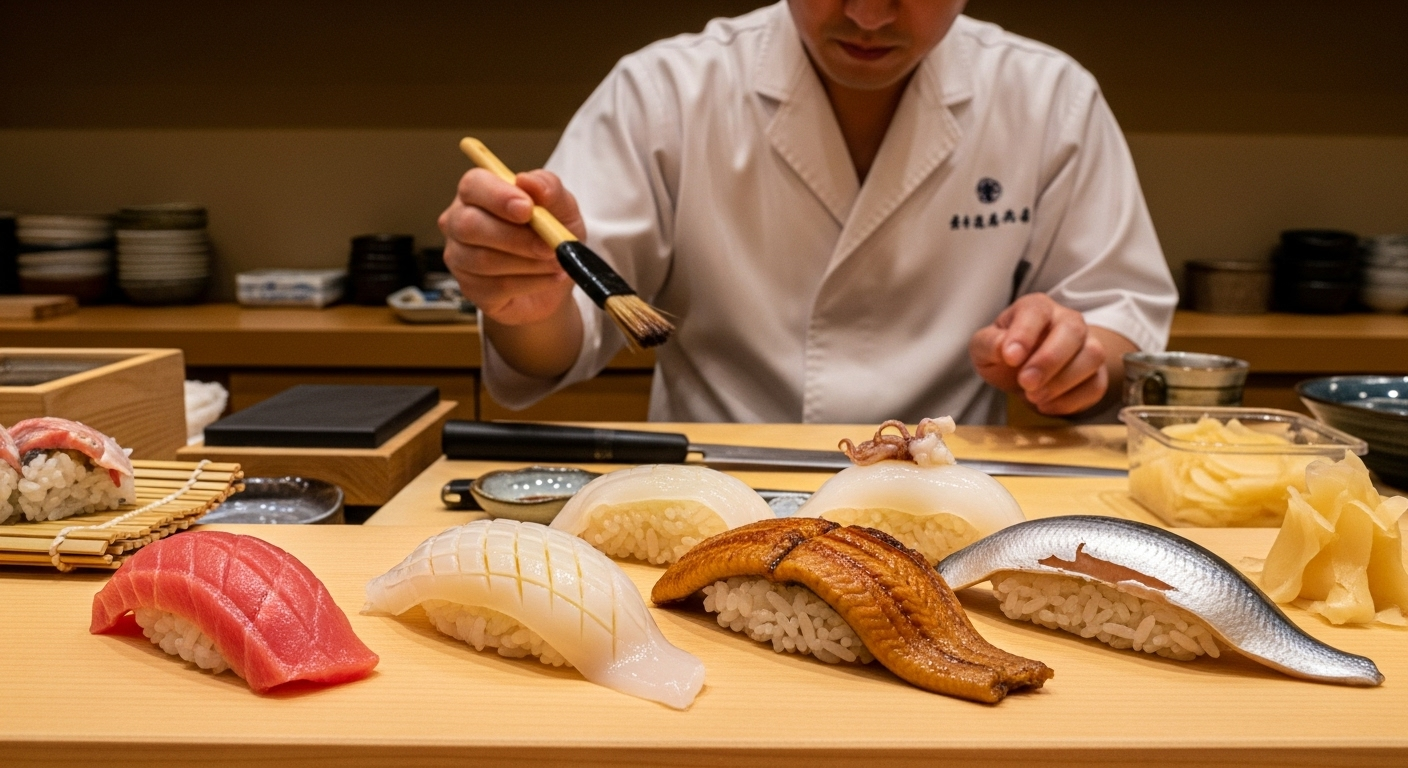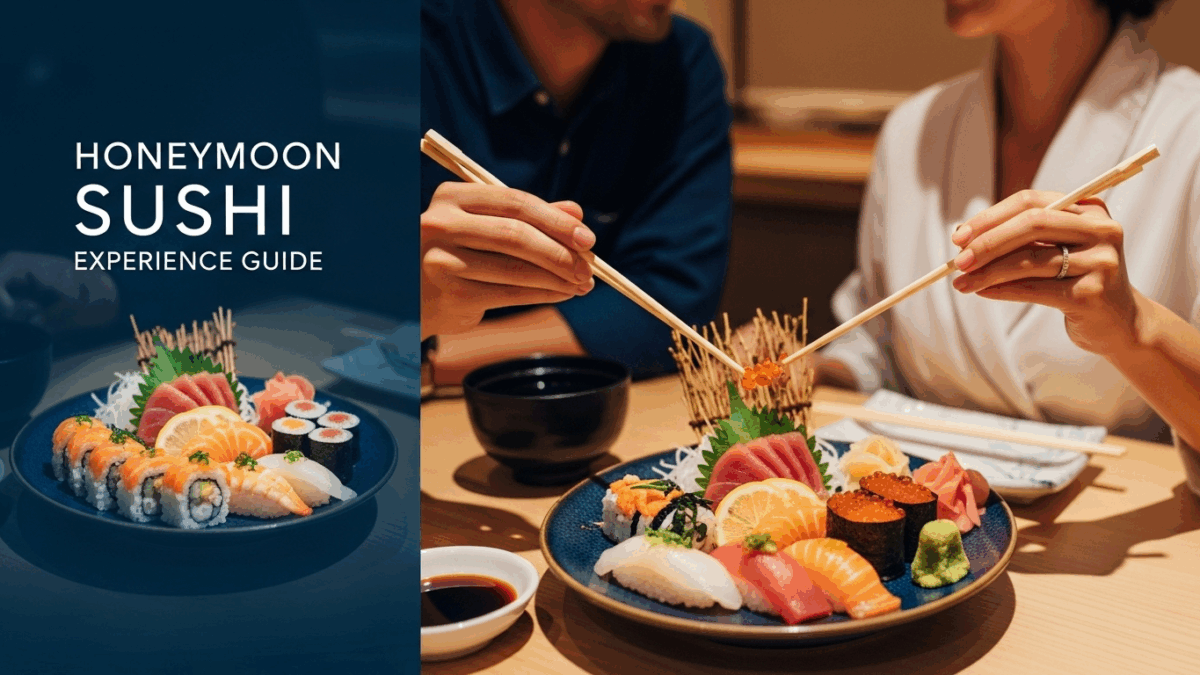A sushi experience in Japan on your honeymoon is far more than just a meal. It’s a private performance, an intimate moment shared across a counter where you can witness a master chef’s artistry up close. It’s an experience that transforms dining into a cherished memory.
Why Choose Sushi for Your Honeymoon?
- An Intimate Setting: Most high-end sushi restaurants seat only 10-15 guests, creating a serene and intimate atmosphere perfect for quiet conversation.
- A Shared Experience: Watching the chef’s precise movements and tasting the same exquisite creations together builds a unique, shared moment of discovery and delight.
- A Lasting Memory: Engaging all five senses—sight, sound, smell, taste, and touch—cements the experience in your memory for years to come.
- A Cultural Connection: Through the chef’s technique and hospitality (omotenashi), you gain a profound insight into the depths of Japanese culture.
The Fundamentals of Sushi
The Soul of Sushi: The Importance of Shari
While many focus on the fish (neta), the true determinant of a sushi’s quality is the seasoned rice, known as shari. Elite restaurants are meticulous about the type of rice, the cooking method, and their unique blend of vinegar. The rice is typically served at body temperature to create the perfect melt-in-your-mouth sensation. When you take your first bite, pay close attention to the flavor and texture of the shari.
The True Meaning of Shun (Peak Seasonality)
In Japanese cuisine, shun refers to the very specific, fleeting period when an ingredient is at its absolute peak of flavor. It’s not just about when it’s available, but when it’s most delicious.
- Spring: Sakura-dai (Cherry Blossom Sea Bream), with its delicate fat before spawning.
- Summer: Shinko (young Gizzard Shad), a tiny, prized delicacy.
- Autumn: Modori-gatsuo (Returning Bonito), richly flavored with a higher fat content.
- Winter: Kan-buri (Winter Yellowtail), with firm flesh forged in cold, rough seas.
The Art of Edomae Sushi: The “Work” (Shigoto)

Edomae (Tokyo-style) sushi is not simply about placing fresh fish on rice. It involves a range of traditional techniques, collectively called shigoto (“work”), designed to maximize the flavor of the fish.
- Shimeru (To Marinate): Curing with salt and vinegar to remove excess moisture and concentrate umami (e.g., kohada, saba).
- Zukeru (To Steep): Marinating in a soy sauce-based mixture to deepen the flavor (e.g., lean tuna).
- Niru (To Simmer): Gently simmering in a sweet and savory broth until tender (e.g., anago, hamaguri).
Choosing Your Sushi Restaurant
Recommendations by Budget
- Luxury (¥20,000+ per person): Famed establishments in Ginza and Nishi-Azabu. Reservations are essential, often months in advance. Here, you will experience the pinnacle of technique and the finest ingredients.
- Mid-Range (¥10,000+): Hidden gems around the old Tsukiji area or in residential neighborhoods. These spots often offer a more relaxed atmosphere where you can enjoy conversation with the chef.
- A Special Experience: Hire a private chef to prepare sushi at your ryokan (traditional inn). This offers the ultimate in privacy and a truly unforgettable, personalized evening for two.
Booking Tips
- Booking through your hotel’s concierge is the most reliable method.
- Aim to book 2-3 months in advance for top-tier restaurants.
- Inform them of any dietary restrictions or allergies when you book.
Etiquette at the Sushi Counter
Basic Courtesies
- Avoid Perfume: The delicate aroma of sushi is a key part of the experience.
- Eat Promptly: The chef serves each piece at its optimal temperature and condition.
- Hands or Chopsticks?: Both are acceptable. If using your hands, use three fingers to lift the sushi gracefully.
- Applying Soy Sauce: Lightly dip the fish side (neta) only. Dipping the rice will cause it to fall apart.
Engaging with the Chef

Conversation with the chef (itamae) is one of the joys of the experience. Feel free to ask:
- “Kono o-sakana wa dochira no sanchi desu ka?” (Where is this fish from?)
- “Dono youna shigoto wo sareteiru no desu ka?” (What kind of “work” has been done to this?)
- “Osusume no nihonshu wa arimasu ka?” (Do you have a recommended sake?)
At the end of your meal, a simple “Oishikatta desu” (It was delicious) is the highest compliment.
Enhancing Your Experience
Sake Pairing
Sake is the perfect companion to sushi. It cleanses the palate, preparing you for the next piece and enhancing the overall journey of flavors.
Seasonal Presentation
First-class restaurants express the season not only through ingredients but also through their choice of serving ware. Look for cherry blossom motifs in spring or pure white plates that evoke a winter snowscape.
Photography
While you may want to capture the beauty of the sushi, always ask for permission before taking a photo. Flashes are strictly forbidden.
Practical Preparations
- Dress Code: Aim for smart casual. A clean, neat appearance is appropriate for the intimate setting.
- Duration: An omakase course typically lasts 1.5 to 2 hours. Plan your schedule accordingly.
- Payment: Some high-end establishments may prefer cash. It’s wise to confirm their policy beforehand.
A Final Word
A sushi experience in Japan is a chance to connect with the nation’s culture and craftsmanship on a deeply personal level. The quiet moments at the counter, the beautiful creations born from the chef’s hands, and the shared delight of each bite—these will all add a unique and brilliant chapter to your honeymoon story.
May this delicious journey deepen your love and enrich your lives. Itadakimasu—with heartfelt gratitude.


